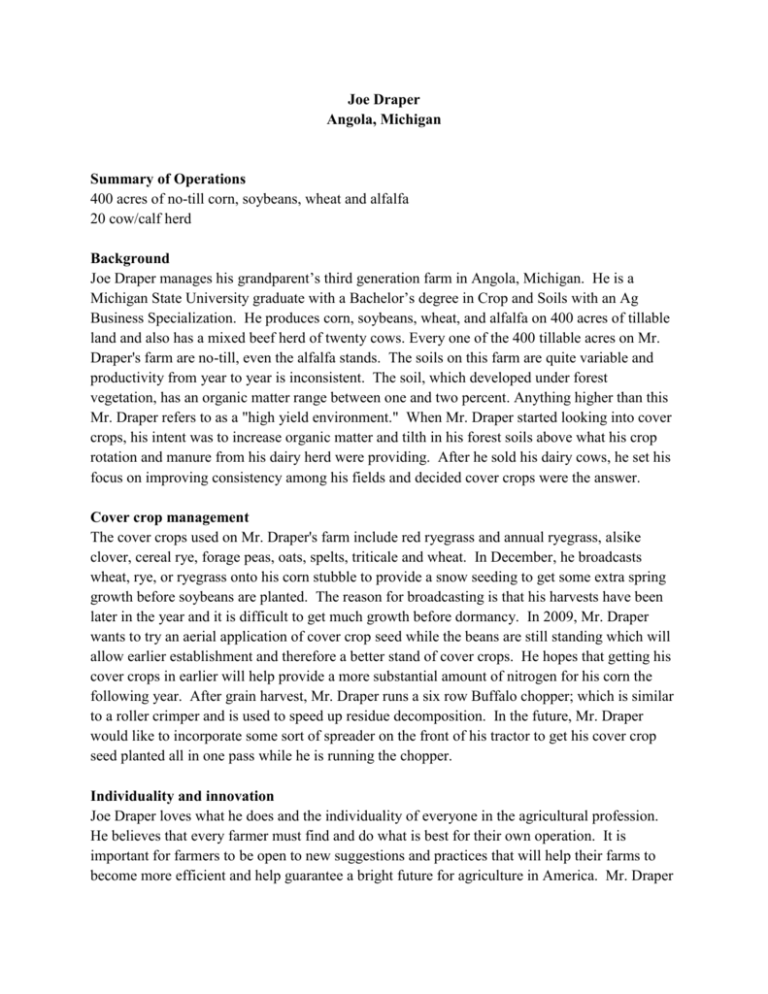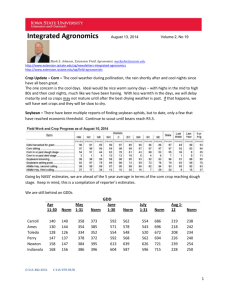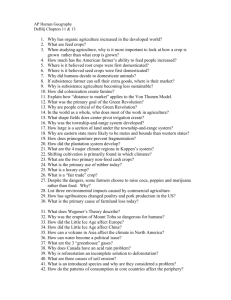Gruver_CoverCropProfilesMichigan_SAEM_2009
advertisement

Joe Draper Angola, Michigan Summary of Operations 400 acres of no-till corn, soybeans, wheat and alfalfa 20 cow/calf herd Background Joe Draper manages his grandparent’s third generation farm in Angola, Michigan. He is a Michigan State University graduate with a Bachelor’s degree in Crop and Soils with an Ag Business Specialization. He produces corn, soybeans, wheat, and alfalfa on 400 acres of tillable land and also has a mixed beef herd of twenty cows. Every one of the 400 tillable acres on Mr. Draper's farm are no-till, even the alfalfa stands. The soils on this farm are quite variable and productivity from year to year is inconsistent. The soil, which developed under forest vegetation, has an organic matter range between one and two percent. Anything higher than this Mr. Draper refers to as a "high yield environment." When Mr. Draper started looking into cover crops, his intent was to increase organic matter and tilth in his forest soils above what his crop rotation and manure from his dairy herd were providing. After he sold his dairy cows, he set his focus on improving consistency among his fields and decided cover crops were the answer. Cover crop management The cover crops used on Mr. Draper's farm include red ryegrass and annual ryegrass, alsike clover, cereal rye, forage peas, oats, spelts, triticale and wheat. In December, he broadcasts wheat, rye, or ryegrass onto his corn stubble to provide a snow seeding to get some extra spring growth before soybeans are planted. The reason for broadcasting is that his harvests have been later in the year and it is difficult to get much growth before dormancy. In 2009, Mr. Draper wants to try an aerial application of cover crop seed while the beans are still standing which will allow earlier establishment and therefore a better stand of cover crops. He hopes that getting his cover crops in earlier will help provide a more substantial amount of nitrogen for his corn the following year. After grain harvest, Mr. Draper runs a six row Buffalo chopper; which is similar to a roller crimper and is used to speed up residue decomposition. In the future, Mr. Draper would like to incorporate some sort of spreader on the front of his tractor to get his cover crop seed planted all in one pass while he is running the chopper. Individuality and innovation Joe Draper loves what he does and the individuality of everyone in the agricultural profession. He believes that every farmer must find and do what is best for their own operation. It is important for farmers to be open to new suggestions and practices that will help their farms to become more efficient and help guarantee a bright future for agriculture in America. Mr. Draper hopes that working for The Nature Conservancy helps his operation to remain more open to new ideas and practices than most other farms. Mr. Draper admits that he does not run the biggest farm but it is his personal goal to "maximize the efficiency and production for ourselves and our tenants and strive for excellence in leading the farm community." Sources Personal communication with Joe Draper by email Profile written by Justin Jones Jim Kratz Caro, Michigan Summary of operation 300 acres of corn, soybeans, wheat and hay Oilseed radish, crimson clover, cereal rye, Austrian winter peas and soybeans have been used as cover crops Background After a brief stint at West Point military academy, Jim Kratz moved back to his hometown of Caro, Michigan, where he has lived nearly all of his forty-six years. He gained experience assisting a cash crop farmer fifteen miles away. Soon after he began his own farming operation acquiring forty acres and some small equipment from his father-in-law. Taking advantage of the inexpensive land prices in the early eighties, Mr. Kratz put together about three hundred acres of owned and rented property in the “thumb” of Michigan. Cash crops raised on his farm include corn, soybeans, wheat, and hay. Three hundred acres is not enough to keep him busy full time, “but enough to build a little equity and make a few bucks in a good year”. Mr. Kratz has worked for the Tuscola County Conservation District for twenty years. He is currently the administrator. A few of his responsibilities include overseeing the district drill program and the Conservation Reserve Enhancement program. He notes major changes within the District over the years, “When I started working at the District we had one fifteen foot John Deere no-till drill. Currently we rent out one fifteen foot drill for smaller customers and three thirty foot no-till air seeders with 8130 MFWD tractors to pull them along. Economics have forced some of the change, plus equipment has gotten a lot better and guys are more comfortable handling residue than they used to be.” The conservation district is where Mr. Katz’s interest in no-till and cover cropping practices originated. Mr. Kratz has been implementing ideas and new perspectives cultured at the National No-till convention, which he attends each year. “The moldboard plow pretty much ruled the area up until about ten years ago or so,” said Kratz. His northern clay soils have been “one hundred percent no-till” for the past ten to fifteen years. Experiences With Cover Crops Mr. Kratz has planted a wide variety of cover crops including oilseed radish, crimson clover, cereal rye, Austrian winter peas, soybeans, and hairy vetch. Currently he spreads cereal rye at the rate of a bushel to the acre on corn stubble, along with 150 to 200 pounds of potash. Last August the rye was applied via airplane with reasonable success. He then plants into the standing rye depending on the spring and then sprays the field with glysophate to kill off the cereal rye. He has had good luck spraying with Extreme (Roundup & Pursuit) right after planting conventional beans, which was his total herbicide program for last year. This spring he plans on spraying the field early with 2 4-D, to reduce perennial broadleaves before planting dry beans later that spring. After wheat and preceding corn he generally plants peas, clover, vetch, or soybeans. These crops provide natural nitrogen fixation. Mr. Kratz has measured anywhere from 50 to 150 pounds of nitrogen at corn side dress. Mr. Kratz said, “the problem that we’ve had is the more biomass we produce the more difficulty we have with slugs and disease in the spring.” He thinks biomass may not be as significant of a problem in other parts of the country. “The cold clay soils of Michigan take a while to warm up.” Mr. Kratz believes efficiently maintaining and improving soil quality is linked to increased microbial activity, which is a direct result of cover crops usage and effective conservation tillage practices. Sources Personal communication with Jim Kratz by e mail (12/01/08) Profile written by Dustin Kurfman Pat M. Sheridan Fairgrove, Michigan Summary of operation 1800 acres of corn, soybeans, wheat, sugar beets Aroostoock rye and Colonel oilseed radish as cover crops. 100% no-till since 1990 Background Pat M. Sheridan started driving a tractor at the age of 8. He was farming full time by the age of 22. Mr. Sheridan went to Michigan State and completed a two year Ag Tech degree in Soil and Chemical technology. Mr. Sheridan and his father now run Sheridan Farms LTD. They have 3 part time employees that help them depending on the time of year. Mr. Sheridan is mainly in charge of marketing, input purchases, chemical and fertilizer needs, and he also operates the planter. He is currently the president of the corporation. His goal is to increase the net worth of the corporation. Mr. Sheridan uses a 3 coulter system only. He has 3 coulters on a cart, and the planter is hooked up behind the cart, which makes it a one pass system. The farm has 12 different soil types, 80% being clay loam. The farm is pretty level with poorly drained lakebed soils that are systematically tiled, 30 ft. to 60 ft. spacings. Cover cropping practices When Mr. Sheridan came back to the farm from college the OM on a lot of the property was under1%. He says that he looks for a cover crop to do multiple things for the farm. He uses cover crops to enhance erosion control, especially wind erosion. Cover crops also increase residue levels; they enhance weed control, reduce compaction and crusting, aid in moisture management, and capture and produce nutrients. Mr. Sheridan says cover crops can also serve as a rotational aid. He says that if he wants to plant a broadleaf cash crop after a broadleaf cash crop he tries to fool Mother Nature by putting in a grass cover in between broadleaf cash crops. He has found that this does not work for corn. Mr. Sheridan says that “planting corn into grass has been a train wreck for us, especially after wheat”. Another good reason for planting cover crops is that it “creates a positive environment for good bugs and micro bugs, leaving the bad bugs out.” Cover crop management Mr. Sheridan says that the easiest way to plant a cover crop is by air. The rotations (planting a grass cover crop between two broadleaf cash crops) are short and that just seems to be the easiest and most cost effective. Another reason for seeding by air is that you do not have to wait for the crops to come out to plant your cover crop. If fertilizer is needed, then a cover crop may be mixed in while applying the fertilizer. Pat says that this works very well with potash and cereal rye. Broadleaf cash crops are almost always planted into living cover crops that are sprayed with glyphosate after planting. Grass cash crops are NEVER planted into anything that is green or living. Cover crop choice is often decided by the weather. If it is a wet year, they will plant a cover crop that takes up a lot of moisture to dry out the soil such as cereal rye. If it becomes dry before planting season, the cereal rye will be killed off earlier so the ground moisture is saved. Cereal rye also helps alleviate topsoil compaction because of the large amounts of fibrous roots. It also helps control weeds such as redroot pigweed and lambs quarter, but it is not consistent in controlling foxtail. Another reason for planting Aroostock cereal rye is that is that it is much easier to kill than wheat and annual ryegrass. Oilseed radish is also commonly used on the Sheridan farm. The advantage of oilseed radish is that it has a great ability to alleviate deep compaction. It is also a very good nitrogen scavenger. Two varieties of oilseed radish control sugar beet cyst nematodes as well. Oilseed radish kills off in the winter and does not have to be controlled by spraying. The only downside to radish is that the seed costs $30/ acre to plant. 25 years and still making improvements Over the years, Mr. Sheridan has found many advantages of cover cropping. He is becoming more successful with more experience. Mr. Sheridan has seen less white-mold in his soybeans. Even on years when his neighboring farmers are having huge problems with white mold, Mr. Sheridan’s beans often show no signs of the disease. Mr. Sheridan has been able to grow more corn with less nitrogen, lower his disease problems, and raise his organic matter with cover crops. Sources: Personal communication by email with Pat M. Sheridan Managing Cover Crops Profitability book Profile written by Dustin Roskamp






